History
GENERAL NOTES
Agia Marina of Xyliatou, the small and beautiful village of Nicosia district is about 40 kilometers far from the capital. It is built on the foot of the Troodos mountain range, in a medium altitude of 450 meters above the sea surface. In a distance of one kilometer from the village to the south, there is the green and marvelous forest ‘Adelphi’.
The village has a marvelous view . From here someone can see from afar the green fields and the blue sea of Morphou, Nicosia and the Pentadaktylos mountain range. To the south west there is the beautiful Troodos mountain range with the most imposing peak of Madaris.
The community is near the villages of Xyliatos (3klm), Kato Moni (3 km), Orounta (5 km) Vyzakia (4 km), Potami (5 km), Peristerona ( 10 km), Mitsero (6 km), Lagoudera (13 km), Saranti (13km) and Nikitari (6 km).
POPULATION
The village is familiar with, for over a century, a steady increase of its population. From the 74 residents in 1881 population was increased to 204 in 1901 and to 342 in 1921, to 418 in 1946, to 516 in 1960, to 546 in 1973 and to 605 in 1982.In the last population census that was conducted in 2001 the residents of the community were 628. Despite the big distance from Nicosia Agia Marina keeps resisting the drift of population to cities.
PRODUCTION
The residents of the community are still busy with the cultivation of land. The main product that the village produce is almond trees some cereals, some legumes, some vines and olives. After the construction of the Xyliatou dam in the area there are some fruit trees too. Stock-breeding is also developed especially of the goat sheep.
NAME
The village was named Agia Marina because of the residents’ respect to the saint and great martyr Marina .The respect that all Cypriots have towards Agia Marina is also well known and this is obvious from the 110 and more churches that are dedicated to Agia Marina. In Cyprus there are four villages with the name Agia Marina . Agia Marina near the village Xyliatos which is known as Agia Marina Xyliatou, the other near Skilloura with Maronites to the residents and two in Paphos district. The one is near the area of Kelokedara known as the Agia Marina of Kelokedaron and the other in the area of Chrysochous with the name Agia Marina of Chrysochous.
By the first decades of the 20th century the village was known as the Agia Marina of Nikitari . But with the coming of the post office, the English established it permanently; in order to distinguish it they named it Agia Marina Xyliatou.
ANTIQUITY OF THE VILLAGE
The community as it seems functions as a settlement from the pre- historic period. Water springs, caves, tombs, rust from copper, galleries and other evidence show the human presence in the area.
The first basic evidence of the village’s antiquity is the spring from where the village was watered until the first decades of the 20th century. This spring exists today and it is the holy water of Agias Marinas.
In the area ‘Maratheftika’ very near the village ancient tombs and caves were discovered . These tombs were pillaged at times .From information we have the pillagers discovered ancient gold coins, gold leaves of Mersinias and small metallic coins. This fact leads us to the conclusion that the village was inhabited from the ancient or Roman age.
In different places of the area of the village there are eternal olive trees until today.
In the location of ‘Mavrovouni’ two kilometers on the east of the village there are important stocks of rust , obvious spots of copper. Also, in the location of ‘Agios Kyriakos’ on the west of the village there is a pile of rust..
On Cyprus’ map «Cypruss Insula» which Abraham Ortelious published in May in 1570, the settlement is noted as S. Marina.This consists the oldest known map of the area of Venice domination , in which the village is noted.
Tour
At the roots of Mount Troodos emerges a small village of unique beauty, Agia Marina Xyliatou. The boundaries of the village were limited up to the beginning of the 20th century within a valley. Nowadays, most of the surrounding hills are included, such as “Moni tou Tholou” (Μονή του Θόλου), “Staurou” (Σταυρού) and “Mazeris” (Μαζερής). What is impressive, and hence worth mentioning, is that the initial ‘birthplace’ of the village still maintains its original character. Let us wander through the narrow streets of the village so as to meet both its traditional and its modern side.
Agia Marina offers a primary school, an old church of Saint Marina, narrow and tortuous roads, small time-honoured houses, traditional coffee shops, unions and small shops. What is striking is the way in which the old houses were built. The basis, the fundaments of the houses, which were not higher than a meter, was built with stone, whilst the rest of the house was built with adobe. Only a small number of houses were built exclusively with stone. What is more, flat roofs in most houses were made of dirt and “konnos”, a waterproof material, which was placed on their highest point.
Additionally, there are two squares in the centre of Agia Marina, namely in the “old Agia Marina”. One of them is situated right next to the entrance of the old church while the second one on the east side of the church. The latter is only a hundred metres away from the previous square, and it is known as “Nefka”.
The square right next to the primary school was considered private property up to 1970. It is now used as the school’s play ground, for wedding receptions, theatrical performances, for celebrations or events of different unions- Association “Dighenis” (Διγενής), “Nea Genea”(Νέα Γενεά) and the Association of expatriates. Seats for a thousand viewers were built on the east side of the square, and it can be, therefore, used as training place for the abovementioned unions.
Agia Marina has a wonderful community park to offer, which is considered not only a meeting point but also a recreation place for the inhabitants of all ages. The park comprises of the fountain of holy water, playground, kiosk and numerous benches. It is one of the main attractions of the villages due the green view it has to offer.
Right across the road, the magnificent culture centre comes into view. It consists of a library, kindergarten, community offices and a hall, which is capable of hosting theatrical performances and can guest up to six hundred viewers.
There are three organised places, ideal for excursion just outside the village centre. The first one is where the dam of Agia Marina is situated. The second one is right next to “Kapoura” station and the third one, namely Gefyri tis Panagias, which is right across to the homonymous silvan station.
Concluding, Agia Marina is one of the villages in Nicosia (Lefkosia) that harmonically combine an excellent landscape; the traditional with the modern elements are marvellously brought together.
Community park
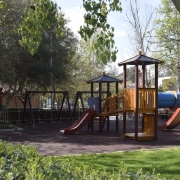
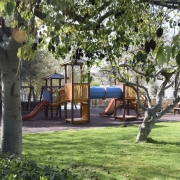
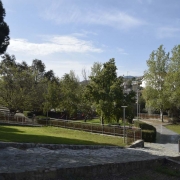
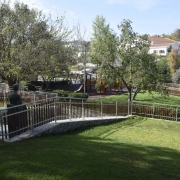
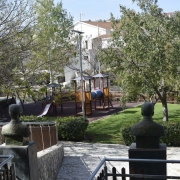
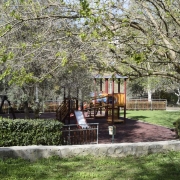


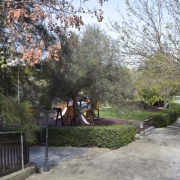
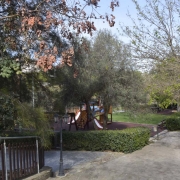
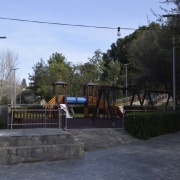
Culture center
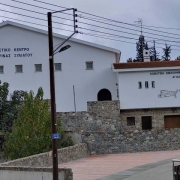
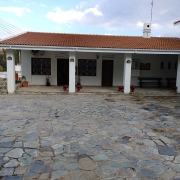
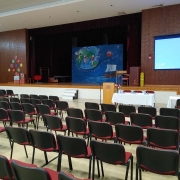
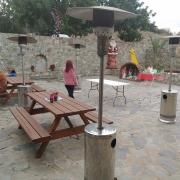
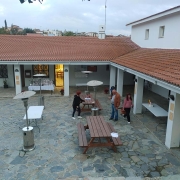
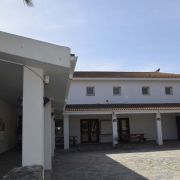
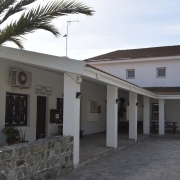
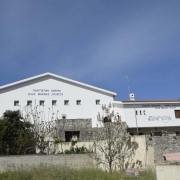
Custons
Chartomata or Engagement
When young peopled reached the age of eighteen or when they had saved some money, they were considered ready to get engaged. The families used to be responsible of finding the prefect match and they always considered as important “their likes and dislikes, the generation and the economical state of the in-laws”.
After the selection of the ‘perfect match’, the matchmaker, who was in most cases a woman, took over the proposal, and if the answer were positive then a wedding date was set.
It is worth mentioning that the inhabitants considered that the best period for engagement was the “love week”, namely the week before the Christmas fasting period that lasts fourty days.
On the day of the engagement, the family of the groom visited the family of the bride and decided on the amount of the dowry offered to the couple by their families. This agreement was consummated by a handshake between the couple and their parents. Tokka, namely handshake for the people of Agia Marina was the equivalent of the honour of a person. It is worth mentioning that the couple got married only after their house was completely built, even if it took a decade to be finished. This was followed by a great banquet, where the god parents were the guests of honour.
Wedding or “armasma” or “stefanomata”
The wedding is a joyful event and everyone in the village took part in the weddings. The invitation was house to house visits by the parents of the couple, who offered “glistarka”, a kind of sesame bread.
On the wedding’s eve, which was on Saturdays, the inhabitants of the village used to go to the house of the bride with their “kanishi”, that is, food such as potatoes, oil, pasta and a chicken. On the afternoon, the best men and the maids of honour re-invited everyone to the wedding offering them rosewater in a silver vessel called “merrecha”. On Saturday afternoon, the bed of the couple was filled with money (gemisma tou krevatiou) by everyone. This custom was at some point transferred for the next day, namely Sunday afternoon. On the same night, all family and friends were gathered at the house where the wedding was to take place and had a feast accompanied by an orchestra with traditional instruments, such as violin and lute.
On the wedding day, on Sunday, everyone in the village helped to prepare the food for the feast in the evening. The bride used to start getting ready at noon at her house accompanied by her friends and traditional music. A few hours later, the groom got ready in a similar atmosphere.
After this, the couple went to the church accompanied by their families, their friends and music. The first to go was the groom. As the newlyweds exited the church, all people present threw “flowers, wheat or rice” at them, as they believed that this helped them grow old together and have many children.
A custom that survived for many years and was believed foretell if the couple was to be happy, had the other of the bride asking the groom to throw a pomegranate on the wall of their house, before entering the house. If the pomegranate broke into many pieces, it meant that the couple would be blissful. This custom was slowly abandoned after 1950.
A big feast with food, drinks and music followed and lasted for a whole day. The next day, Monday, friends and family visited the newlyweds so as to offer them their ‘Monday present’ and to eat pasta and traditional pies with honey.
On Monday afternoon, all best men and maids of honour invited everyone to the Monday party and to see the couple dancing. During this wedding dance everyone gave money to the couple in a rather extraordinary manner. They pinned money and clothing on the couple’s clothes while they were dancing.
The wedding used to last until Tuesday and on the following Sunday, when a kind of second wedding took place so as to offer more food and music. What is more, the couple received money.
Christmas Customs
Before Christmas, all housewives started reparations for Christmas. Preparations included cleaning the house and baking traditional delicacies, such as daktulies and glistakres.
It is worth mentioning that everyone who worked elsewhere always came in Agia Marina to spend Christmas there.
On Christmas day, everyone went to the church at 4 in the morning so as to see the same star that led the three wise men to Christ.
After church, they used to gather and eat the traditional trachana soup. At noon they ate meat, “kolokasi” and mushrooms they found in the forest.
New Year’s
On New Year’s Eve, housewives prepared the New Year’s pie and put a coin inside.
On New Year’s Eve, the family would sit around the “tsiminia”, a kinf od fireplace. They used to throw leaves of olive trees on the fire, after they prayed to Saint Nicolas (Agios Vassilis) to show if their chosen one loved them back. If the leaf jumped, this meant that their beloved one felt the same way.
The housewives used to set the table for Agios Vassilis. They offered him a pie especially made for him, a bottle of wine with a glass, the wallet of the landlord and a lit candle. Agios Vassilis was believed to visit each and every house on that day, so as to bless the new year and offer health, love, happiness and wealth.
On New Year’s morning, the children found presents or money (pouloustrina) in their shoes. They were supposed to be a present from Agios Vassilis. The owner of the house would then cut the pie and offer pieces to everyone. Who ever found a coin in their piece were considered lucky all year round.
Kalanta
On Epiphany Day’s eve or Kalanta, everyone went to the church in order to get holy water (agiasmos). They would then water their “animals, gardens, trees” so as to be fructiferous.
After Mass the village’s priest used to go around all the houses holding a cross and “matsa” a cluster of olive tree leaves so as to sprinkle people with holy water and bless them. All housewives welcomed the priest by offering food.
Another custom regarding Epiphany Day is the preparation of loukoumades, a kind of doughnut for the kalikantzari. According to tradition, kalikantzari are bugbears that appear as animals or scary old men and wish to frighten humans. Therefore, all housewives prepare loukoumades and throw them on the roofs of their houses for the kalikantzari to eat and leave.
Carnival
Carnival or Apokries was a festive period, which lasted the days.
All housewives prepared traditional food throughout these ten days. People used to gather and had fun while eating the food each family brought.
The carnival feast included eating and drinking, playing, dressing up and singing. One of the most famous traditional games is the game with the egg. They used to hang a boiled egg with a thread on the ceiling, above the table and everyone there were trying to catch it with their mouths.
Green Monday
On Green Monday, namely the day signifying the beginning of the Easter fasting period everyone had picnics in the fields surrounding the village.
An old custom has a young lady dressed as a bride riding a donkey and visiting everyone while having a picnic. She was accompanied by musicians and people singing.
Swing or Souses
Souses was a traditional game especially for young women during the Easter holidays. The girls would hang a swing on a wooden or iron beam (neuka).
Then four of them would sit on the sousa and started to swing, with the help of young men. The girls sung during this game.
Easter Holidays
Preparations for Easter started a week before Easter Sunday. All housewives would dye eggs red and bake “flaounes”, a traditional Cypriot kind of cheese-bread. All men would bring logs of wood from Adelphi forest, in order to light the Lambratzia, a kind of bonfire, where Judas is burned.
On the night of Holy Saturday everyone is at the church. At midnight the priest announces that “Christ has risen” and everyone lights a candle.
After Mass they used to go home and eat flaouna with lamb and a traditional soup, Augolemoni, made of chicken and lemons.
On Easter Sunday, after the Mass of love, all people shake hands and say “Christ has risen”.
Then they gather up at the church’s parvis and play a game especially for youn men called “ditzimi”. They had to lift a big stone, and the men who accomplished that, were considered the strongest men of the village.
The easter meal included food and traditional drinks such as “zivania” and wine. After that all people from Agia Marian would gather up in Nefka and played traditional games such as “triappithkia”, “ziziros”, “potamos”, “sika” and “kattomougias”.
The most famous and amusing game is donkey rides. Donkeys have to run 3 kilometres and the first to make it is the winner. Most of these customs and all of these games are revived in Agia Marina every Easter.
Community futsal



Natural Environment
The picturesque small village of Agia Marina seems to arise from the extensive green valley surrounding the deep blue sea of Morphou. On its southern part, lies the forest “Adelphi”, whilst it is filled with ancient olive trees. The natural environment of Agia Marina includes fructiferous trees and wild plantation as well. Let’s meet its natural beauty!
The “Adelphi” forest covers an area of 128,9 square kilometres. The forest is the natural southern border for Agia Marina Xyliatou. It is worth mentioning that wooden homesteads were built on the highest point of the forest, namely hill Mazeri. These function as offices, observation towers as well as accommodation units for rangers. It is extremely interesting that Jack Goodwin refers to “Adelphi” forest as a sylvan centre at the end of the 18th century.
As mentioned above, ancient trees can be found in the village, trees that go back to the beginning of the 15th century. Two of them are two olive trees found at the Agios Kyriacos or Ay Tzirkakos area. They are known as “the olive trees of Kattimeritzis”. Another two olive trees, the “olive trees of Hadjiakimis” are found at the “Pithkia” and “Kapparkes” areas accordingly.
Consequently, Agia Marina Xyliatou has an extraordinarily beautiful scenery to offer, as it emerges majestic out of the local plantation.

